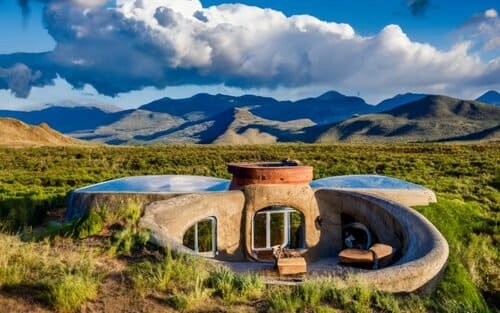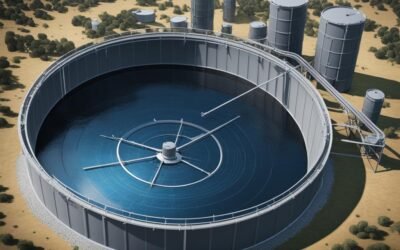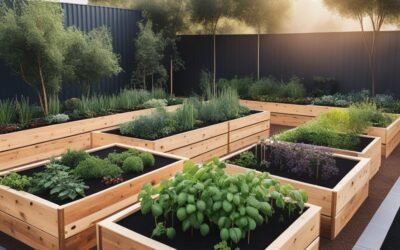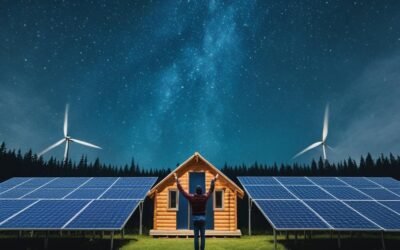In the 1970s, a visionary approach to sustainable architecture emerged with the advent of retro 70s Earthship homes. These unique dwellings captured the essence of eco-consciousness and self-sufficiency, paving the way for a more environmentally friendly future. As we explore the world of Earthships today, we can witness the enduring relevance and impact of these sustainable homes.
Earthships are more than just houses; they embody a philosophy of sustainable living. Designed to be off-grid and eco-friendly, these homes integrate ingenious concepts such as passive solar design, recycled materials, and renewable energy systems. By harnessing the power of nature, Earthships offer a glimpse into a greener, more sustainable way of life.
Key Takeaways:
- 70s Earthship homes emerged as pioneers of sustainable architecture in the 1970s.
- These homes were designed to be self-sufficient and eco-friendly, utilizing passive solar design and recycled materials.
- Construction of Earthships involves incorporating recycled materials such as tires, cans, and bottles.
- Renewable energy systems, including solar panels and wind turbines, power these homes.
- Earthships enable off-grid living, promoting self-sufficiency and reducing reliance on public utilities.
What is an Earthship?
An Earthship is a unique type of home that is built using eco-friendly and recycled materials, with a focus on off-grid living and sustainable practices. These homes are designed to be self-sufficient, minimizing their impact on the environment while providing a comfortable and healthy living space.
Earthships utilize passive solar design, harnessing the sun’s energy to provide heating and lighting without relying on traditional energy sources. The walls of Earthships are made from salvaged materials such as tires, cans, and bottles, which not only reduce waste but also provide excellent insulation, keeping the homes cool in summer and warm in winter.
One of the key features of an Earthship is its off-grid capability. These homes incorporate renewable energy systems such as solar panels and wind turbines, allowing residents to generate their own electricity and reduce their dependence on the power grid. Water systems in Earthships also promote self-sufficiency, with rainwater harvesting and wastewater treatment systems that minimize water consumption and waste.
Living in an Earthship means embracing a sustainable lifestyle. These homes are not only designed to minimize environmental impact but also to provide a comfortable and healthy living environment for residents. The use of natural materials and passive solar design contributes to improved indoor air quality and temperature regulation, creating a harmonious and nurturing living space.
An Earthship is not just a home; it is a statement of commitment to environmental stewardship and sustainable living. By choosing to live in an Earthship, individuals and families are actively contributing to a greener future, reducing their carbon footprint, and inspiring others to adopt eco-friendly practices.
How are Earthships made?

Earthships are constructed using a variety of recycled materials, including tires, cans, and bottles. These unconventional building materials not only minimize waste but also contribute to the unique and artistic aesthetic of Earthship homes.
The construction process begins with the tires, which are filled with compacted earth, also known as rammed earth, and then stacked to form the walls of the Earthship. This technique provides excellent thermal mass and insulation, allowing the homes to naturally regulate temperature and reduce energy consumption.
Recycled bottles play a crucial role in Earthship construction as well. They are used to create beautiful mosaic-like windows that not only let natural light in but also add a touch of artistic flair to the interior. These windows are strategically placed to maximize daylighting and minimize the need for artificial lighting during the day.
In addition to tires and bottles, Earthships incorporate other salvaged materials like wood and metal into their construction. These materials are repurposed and often upcycled, further enhancing the sustainability and eco-friendliness of the building process.
As a result of this innovative use of recycled materials and eco construction methods, Earthships are not only environmentally friendly but also visually captivating structures. They showcase the potential of sustainable architecture in creating homes that are both functional and aesthetically pleasing.
Energy and Water Systems in Earthships

When it comes to sustainable living, Earthships lead the way by utilizing renewable energy systems and rainwater harvesting techniques. These innovative homes are designed to be self-sufficient, reducing reliance on public utilities and promoting a greener and more sustainable future.
- Renewable energy: Earthships harness the power of the sun through the use of solar panels. These panels generate clean electricity, which is stored in batteries for later use. By relying on renewable energy sources, Earthship residents can significantly reduce their carbon footprint and lower their energy costs.
- Rainwater harvesting: Earthships have cleverly designed systems to collect and filter rainwater. This harvested water can be used for various purposes, such as washing, bathing, and even watering indoor and outdoor gardens. By maximizing the use of rainwater, Earthships conserve precious resources and promote water self-sufficiency.
Additionally, wind turbines can be installed alongside solar panels to further supplement the energy production. This combination of renewable energy sources ensures a consistent and reliable power supply for Earthship dwellers.
By harnessing renewable energy and implementing rainwater harvesting systems, Earthships strive to achieve self-sufficiency and reduce reliance on public utilities. This not only benefits the environment but also allows residents to live a more sustainable lifestyle.
| Benefits of Energy and Water Systems in Earthships |
|---|
| 1. Reduced carbon footprint through the use of renewable energy |
| 2. Lowered energy costs by maximizing clean energy sources |
| 3. Enhanced water self-sufficiency through rainwater harvesting |
| 4. Conserved water resources for sustainable use |
| 5. Increased resilience and reliability with combined solar and wind energy |
Earthships and the Off-Grid Lifestyle

Living off-grid and embracing a sustainable lifestyle is becoming increasingly popular in today’s world. Earthships provide a unique opportunity for individuals to disconnect from traditional public utilities and create a self-sufficient living environment. By harnessing renewable energy and implementing sustainable systems, Earthship dwellers can minimize their ecological footprint and lead a more sustainable lifestyle.
Earthships are designed to provide their own electricity, heating, and water supply, reducing dependency on external resources. Through the use of solar panels and wind turbines, residents can generate clean and renewable energy. This allows them to power their homes and live comfortably without relying on the grid.
One of the key features of Earthships is their efficient water management system. These sustainable homes collect and filter rainwater, which can be used for various purposes such as washing, bathing, and even watering gardens. By conserving and reusing water, Earthship dwellers contribute to a more sustainable water cycle.
By embracing the off-grid lifestyle offered by Earthships, individuals can achieve a high level of self-sufficiency. They have the freedom to live off the land, grow their own food, and reduce their reliance on external resources. This not only promotes a greener future but also provides a sense of empowerment and resilience.
Earthships are at the forefront of sustainable living practices and offer a unique and fulfilling way of life. Through their innovative design and utilization of renewable resources, these homes showcase the possibilities of off-grid living and self-sufficiency. By adopting this eco-friendly lifestyle, individuals can make a positive impact on the environment and contribute to a more sustainable future.
Noteworthy Earthship Communities and Designs

Earthship communities have emerged as vibrant hubs for sustainable living and innovation. These communities, such as the Greater World Community in Taos, New Mexico, showcase a variety of Earthship designs and serve as educational centers for sustainable architecture and off-grid living.
One notable Earthship design is The Phoenix, a radical and artistic home that blends unconventional elements. This unique Earthship stands as a testament to creativity and showcases the endless possibilities of sustainable architecture.
Another remarkable Earthship design is The Vallecitos, a modern and energy-efficient Earthship that exudes rustic charm. With its efficient layout and sustainable systems, The Vallecitos demonstrates how eco-friendly design can seamlessly merge with aesthetic appeal.
Within these Earthship communities, residents have the opportunity to connect with like-minded individuals who share a passion for sustainable living. Together, they cultivate a sense of belonging and actively contribute to the growth and development of these unique communities.
Design Showcase: The Phoenix
“The Phoenix is a true testament to the power of sustainable design. Its unconventional architecture and artistic elements make it a standout example of Earthship ingenuity.”
Design Case Study: The Vallecitos
“The Vallecitos seamlessly blends modernity and rustic charm. This energy-efficient Earthship showcases the potential of sustainable design in creating comfortable and visually stunning living spaces.”
Conclusion
Retro 70s Earthship homes are a testament to the possibilities of eco-friendly houses and sustainable living. These unique dwellings continue to inspire and captivate with their innovative design and off-grid capabilities. By utilizing recycled materials, renewable energy systems, and sustainable water management, Earthships challenge conventional notions of housing and pave the way for a greener future.
Earthships provide a glimpse into a more self-sufficient way of living. Through their passive solar design, these homes harness energy from the sun for heating and lighting, reducing reliance on traditional energy sources. The use of recycled materials, such as tires and bottles, not only minimizes waste but also provides natural insulation and creates beautiful, artistic features.
Living in an Earthship means embracing a sustainable lifestyle. These homes enable residents to reduce their ecological footprint by generating their own clean electricity through solar panels, storing it in batteries for later use, and harnessing wind power when needed. Rainwater harvesting systems allow for self-sufficiency in water supply, minimizing the need for traditional utility services.
As we move towards a more sustainable and eco-conscious era, Earthships serve as a beacon of innovation and possibility. These homes challenge the status quo of green building and demonstrate that sustainable living can be comfortable, aesthetically pleasing, and environmentally responsible. By adopting the lessons and principles of Earthships, we can create a future where eco-friendly houses and green building practices are the norm, leading us towards a more sustainable and resilient world.
FAQ
What is an Earthship?
Earthships are homes built with eco-friendly and recycled materials, designed to be off-grid and self-sufficient. They typically utilize passive solar design, which harnesses the sun’s energy for heating and lighting. The walls of Earthships are made from salvaged materials like tires, cans, and bottles, providing natural insulation. These homes also incorporate systems for rainwater harvesting and wastewater treatment, allowing residents to live in a sustainable and environmentally friendly manner.
How are Earthships made?
Earthships are constructed using a variety of recycled materials, including tires, cans, and bottles. The tires are filled with compacted earth and stacked to form the walls, providing excellent thermal mass and insulation. Recycled bottles are used to create beautiful mosaic-like windows that allow natural light to enter the homes. Other salvaged materials, such as wood and metal, are also incorporated into the construction process. The result is a unique and artistic structure that showcases the potential of eco construction.
What energy and water systems are used in Earthships?
Earthships utilize renewable energy systems to provide electricity and heating. Solar panels are commonly used to generate clean electricity, which is stored in batteries for later use. Wind turbines can also be installed to supplement the solar energy production. In terms of water systems, Earthships are designed to collect and filter rainwater. This water is then used for various purposes, such as washing, bathing, and even watering indoor and outdoor gardens. The goal is to achieve self-sufficiency and reduce reliance on public utilities.
What is off-grid living and how does it relate to Earthships?
Off-grid living refers to a lifestyle in which individuals or communities are self-sufficient and disconnected from traditional public utilities. Earthships offer the opportunity for off-grid living, allowing residents to live in a self-sufficient manner. These homes provide their own electricity, heating, and water supply, reducing dependency on external resources. By harnessing renewable energy and implementing sustainable systems, Earthship dwellers can minimize their ecological footprint and lead a more sustainable lifestyle. This off-grid living approach aligns with the increasing interest in sustainable and eco-friendly practices.
Are there any noteworthy Earthship communities and designs?
Yes, Earthship communities have emerged as hubs for sustainable living and innovation. These communities, such as the Greater World Community in Taos, New Mexico, showcase a variety of Earthship designs and serve as educational centers for sustainable architecture and off-grid living. Some notable Earthship designs include The Phoenix, a radical and artistic home that blends unconventional elements, and The Vallecitos, a modern and energy-efficient Earthship with rustic charm. These communities and designs exemplify the possibilities of sustainable and unique housing solutions.
Are Earthships still relevant today?
Retro 70s Earthship homes continue to inspire and captivate with their sustainable design and off-grid capabilities. By utilizing recycled materials, renewable energy systems, and sustainable water management, Earthships showcase the possibilities of eco-friendly houses. These homes provide a glimpse into a more self-sufficient and sustainable way of living, challenging conventional notions of housing and promoting a greener future. As we look towards a more sustainable and eco-conscious era, the lessons and principles of Earthships remain relevant and influential.













